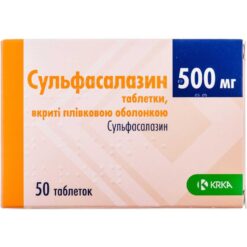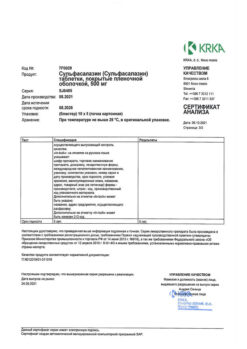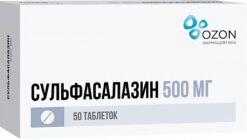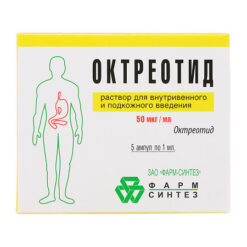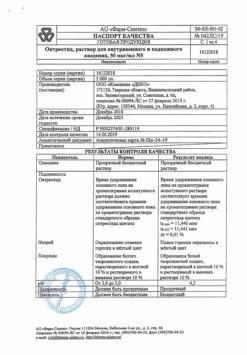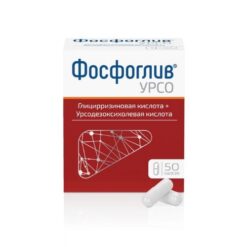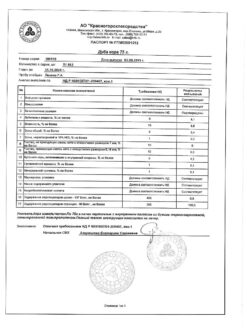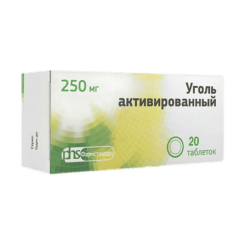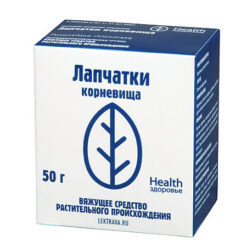No products in the cart.
Escape, 120 mg 112 pcs.
€23.43 €20.30
EAN: 4601669009838
SKU: 269320
Categories: Medicine, Stomach, intestines, liver, Ulcer and gastritis
Description
Gastroprotective and antiulcer agent with bactericidal activity against Helicobacter pylori. It also has anti-inflammatory and astringent action.
In the acidic environment of the stomach, insoluble bismuth oxychloride and citrate are precipitated; chelated compounds with protein substrate are formed in the form of a protective film on the surface of ulcers and erosions.
Thereby the drug forms a protective layer which for a long period of time protects the affected areas of the mucous membrane from the influence of aggressive factors. By increasing the synthesis of prostaglandin E, mucus formation and hydrocarbonate secretion, it stimulates the activity of cytoprotective mechanisms and increases resistance of the gastrointestinal mucous membrane to the influence of pepsin, hydrochloric acid, enzymes and salts of bile acids.
Leads to the accumulation of epidermal growth factor in the defect area. Reduces the activity of pepsin and pepsinogen.
Pharmacokinetics
It is practically not absorbed from the gastrointestinal tract. It is excreted mainly with the feces. A small amount of bismuth entered the plasma is excreted by the kidneys.
Indications
Indications
– Functional dyspepsia not associated with organic diseases of the gastrointestinal tract;
– chronic gastritis and gastroduodenitis in the acute phase, including those associated with Helicobacter pylori;
– peptic ulcer of the stomach and duodenum in the acute phase, including those associated with Helicobacter pylori;
– irritable bowel syndrome, which occurs predominantly with symptoms of diarrhea.
Pharmacological effect
Pharmacological effect
Gastroprotective and antiulcer agent with bactericidal activity against Helicobacter pylori. It also has anti-inflammatory and astringent effects.
In the acidic environment of the stomach, insoluble bismuth oxychloride and citrate are precipitated, and chelate compounds are formed with the protein substrate in the form of a protective film on the surface of ulcers and erosions.
Thus, the drug forms a protective layer, which for a long period of time protects the affected areas of the mucous membrane from the influence of aggressive factors. By increasing the synthesis of prostaglandin E, mucus formation and bicarbonate secretion, it stimulates the activity of cytoprotective mechanisms, increases the resistance of the gastrointestinal mucosa to the effects of pepsin, hydrochloric acid, enzymes and bile salts.
Leads to the accumulation of epidermal growth factor in the defect area. Reduces the activity of pepsin and pepsinogen.
Pharmacokinetics
Practically not absorbed from the gastrointestinal tract. It is excreted mainly in feces. A small amount of bismuth entering the plasma is excreted from the body by the kidneys.
Special instructions
Special instructions
The drug should not be used for more than 8 weeks. It is not recommended to exceed the established daily doses for adults and children during treatment. During treatment with the drug, you should not use other drugs containing bismuth (see section “Interaction with other drugs”). At the end of a course of treatment with the drug in recommended doses, the concentration of the active substance in the blood plasma does not exceed 3 – 58 mcg/l, and intoxication is observed only at concentrations above 100 mcg/l.
When using bismuth tripotassium dicitrate, stool may turn dark.
due to the formation of bismuth sulfide.
Sometimes there is a slight darkening of the tongue.
Alcohol consumption is not recommended during therapy.
Impact on the ability to drive vehicles and machinery
There are no data on the effect of Escape® film-coated tablets on the ability to drive vehicles and operate machinery.
Active ingredient
Active ingredient
Bismuth tripotassium dicitrate
Composition
Composition
Active substance:
bismuth tripotassium dicitrate – 300.00 mg, in terms of bismuth oxide – 120.00 mg.
Excipients:
corn starch – 54.22 mg,
povidone (medium molecular weight polyvinylpyrrolidone, povidone K 25) – 42.00 mg,
polacrilin (potassium polacrilin) - 20.00 mg,
magnesium stearate – 3.78 mg.
Shell:
AquaPolish® P white 019.49 MS [Hydroxypropyl methylcellulose (E 464) – 7.80 mg; hydroxypropylcellulose (E 463) – 1.30 mg, stearic acid (E 570) – 0.91 mg; talc (E 553b) – 1.30 mg; polyethylene glycol – 0.39 mg; titanium dioxide (E171) – 1.30 mg] – 13.00 mg.
Pregnancy
Pregnancy
Bismuth tripotassium dicitrate is contraindicated for use in pregnant women. If it is necessary to use the drug during lactation, breastfeeding should be stopped.
Contraindications
Contraindications
Increased individual sensitivity to the components of the drug;
pregnancy;
breastfeeding period;
taking medications containing bismuth;
chronic renal failure;
children under 4 years of age.
Side Effects
Side Effects
The following adverse events noted with the use of bismuth tripotassium dicitrate are distributed according to the frequency of occurrence in accordance with the following gradation: very often (≥ 1/10); often (≥ 1/100, < 1/10); uncommon (≥ 1/1000, < 1/100); rare (≥ 1/10,000, < 1/1,000); very rare (<1/10,000).
From the gastrointestinal tract: very often – black stool; uncommon – nausea, vomiting, diarrhea or constipation.
Allergic reactions: infrequently – skin rash, itching; very rarely – anaphylactic reactions.
From the nervous system: very rarely – with prolonged use in high doses
– encephalopathy associated with the accumulation of bismuth in the central nervous system.
Side effects are reversible and disappear quickly after discontinuation of the drug.
Interaction
Interaction
For half an hour before and half an hour after taking the drug, it is not recommended to take other medications internally, as well as take food and liquids, in particular antacids, milk, fruits and fruit juices. This is due to the fact that when taken orally simultaneously, they can affect the effectiveness of bismuth tripotassium dicitrate.
The drug reduces the absorption of tetracyclines.
The drug is not used simultaneously with other drugs,
containing bismuth, since the simultaneous use of several drugs
bismuth increases the risk of side effects, including the risk of developing
encephalopathy.
Overdose
Overdose
When using the drug in doses tens of times higher than recommended, or with prolonged use of excessive doses of the drug, bismuth poisoning may develop.
Symptoms: dyspepsia, rash, inflammation of the oral mucosa, characteristic darkening in the form of blue lines on the gums; with long-term use in doses exceeding the recommended ones, renal function may be impaired.
These symptoms are completely reversible when the drug is discontinued.
Treatment: there is no specific antidote. In case of an overdose of the drug, gastric lavage, intake of enterosorbents and symptomatic therapy aimed at maintaining kidney function are indicated.
In case of overdose, the administration of saline laxatives is also indicated. Further treatment should be symptomatic. In case of impaired renal function, accompanied by a high level of bismuth in the blood plasma, complexing agents – dimercaptosuccinic and dimercaptopropanesulfonic acids – can be administered. With the development of severe renal dysfunction, hemodialysis is indicated.
Storage conditions
Storage conditions
Store at a temperature not exceeding 25 °C.
Keep out of the reach of children.
Shelf life
Shelf life
2 years.
Manufacturer
Manufacturer
Pharmstandard-Leksredstva, Russia
Additional information
| Shelf life | 2 years. |
|---|---|
| Conditions of storage | Store at a temperature not exceeding 25 °С. Keep out of reach of children. |
| Manufacturer | Pharmstandard-Leksredstva, Russia |
| Medication form | pills |
| Brand | Pharmstandard-Leksredstva |
Related products
Buy Escape, 120 mg 112 pcs. with delivery to USA, UK, Europe and over 120 other countries.


